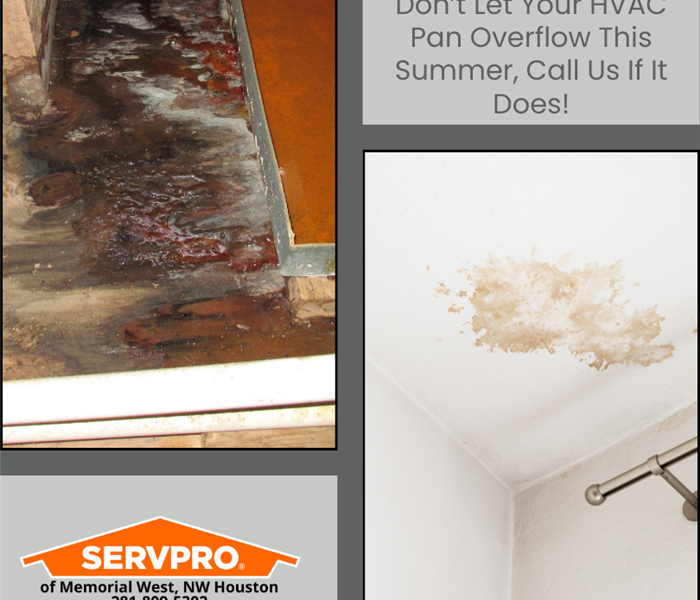Title: The Hidden Menace: HVAC Pan Overflow - Prevention, Signs, and Remediation
5/10/2024 (Permalink)
 Don't let your HVAC overflow pan cause mold and water damage. Keeping your HVAC system maintained is crucial, especially with the hot Houston summers.
Don't let your HVAC overflow pan cause mold and water damage. Keeping your HVAC system maintained is crucial, especially with the hot Houston summers.
During the scorching Houston summer, there's a silent threat lurking within our homes - the HVAC (Heating, Ventilation, and Air Conditioning) pan overflow. As temperatures soar and humidity levels skyrocket, our HVAC systems work tirelessly to keep us cool and comfortable. However, this continuous operation can sometimes lead to unexpected consequences, including water damage and mold growth, if the HVAC pan overflows.
Signs of a HVAC Pan Overflow:
- Water Stains: Keep an eye out for water stains on ceilings, walls, or near the HVAC unit. These stains may indicate that water has leaked from the pan and caused damage to your home's interior.
- Musty Odors: A musty or moldy smell in your home could be a sign of hidden water damage or mold growth caused by an overflowing HVAC pan.
- Visible Mold: Mold thrives in moist environments, making an overflowed HVAC pan an ideal breeding ground. If you notice any signs of mold growth around your HVAC unit or in nearby areas, it's essential to address the issue promptly.
- Pooling Water: Check around the base of your HVAC unit for any pooling water, as this may indicate that the pan is overflowing and leaking water onto the floor.
Prevention Measures:
- Regular Maintenance: Schedule routine maintenance for your HVAC system to ensure that it's functioning correctly and that the pan is clean and free of debris.
- Inspect the Pan: Periodically inspect the HVAC pan for signs of damage or corrosion, and replace it if necessary. Additionally, consider installing a secondary drain pan as a backup measure.
- Monitor Humidity Levels: Keep an eye on indoor humidity levels, especially during hot and humid weather. High humidity can increase the likelihood of an HVAC pan overflow, so use a dehumidifier if needed.
- Professional Inspection: Hire a professional HVAC technician to inspect your system annually and address any potential issues before they escalate.
When SERVPRO of Memorial West, NW Houston Can Help:
If you've experienced water damage or suspect mold growth due to an HVAC pan overflow, SERVPRO of Memorial West, NW Houston is here to assist you. Our team of trained professionals specializes in water damage restoration and mold remediation, utilizing advanced techniques and equipment to restore your home to its pre-damage condition.
We understand the urgency of water damage situations and offer 24/7 emergency services to quickly mitigate the problem and prevent further damage to your property. From water extraction and drying to mold removal and deodorization, we'll work efficiently to restore your home and provide peace of mind.
Don't let an HVAC pan overflow wreak havoc on your home. With proactive prevention measures and the prompt assistance of SERVPRO of Memorial West, NW Houston, you can safeguard your home against water damage and mold growth, ensuring a safe and comfortable living environment for you and your family.
In conclusion, while the hot and humid Houston summers can put a strain on our HVAC systems, it's essential to remain vigilant and proactive in preventing and addressing potential issues such as pan overflows. By staying informed, implementing preventive measures, and knowing when to seek professional assistance, you can protect your home from the damaging effects of water and mold.




 24/7 Emergency Service
24/7 Emergency Service